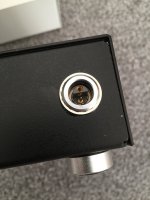You are right; shielding, twisting and grounding the shield on both ends. Reducing the length and using a better quality DC Jack would have helped too. But whether it would have made an audible difference, only experimentation can tell.Basically, you shielded the long DC Cable. Would reducing the length have helped ? ?
Shields are normally not connected at both sides. The best DC jack is not to use any at all. Exactly the wrong connector for the purpose. Any quality screw terminal or even industrial crimped connectors are both better with regards to contact resistance. But that is structural improvement and has no fancy names and requires some skills so not popular.
Ah well I throw a fancy name. One could use Lemo connectors with very good results. Way better for the purpose.
Ah well I throw a fancy name. One could use Lemo connectors with very good results. Way better for the purpose.
Attachments
Last edited:
Thank you for your thoughts.Shields are normally not connected at both sides. The best DC jack is not to use any at all. Exactly the wrong connector for the purpose. Any quality screw terminal or even industrial crimped connectors are both better with regards to contact resistance. But that is structural improvement and has no fancy names and requires some skills so not popular.
Ah well I throw a fancy name. One could use Lemo connectors with very good results. Way better for the purpose.
I am aware and usually connect shield only at the source end. But in the instant case, connecting at both ends, Shanti and chassis of Rpi and DAC improved bass and it's audible and repeatable. I have no clue why. But this shield connection at both ends also reduces perceived depth in sound stage.
In every case, direct soldering of cables is better than the connectors we all use for convenience and flexibility.
If terminating cables wrong results in better sound quality then there is something else that is not entirely optimal. Maybe you could measure what is happening as listening can cause misjudgment.
Soldering of cables is not better than connectors (well, in the case of the standard DC jacks it is 🙂). In the industry this practice is not allowed for quite some time now. Using excellent connectors is the middle point of good electrical connections with convenience, flexibility and serviceability.
Soldering of cables is not better than connectors (well, in the case of the standard DC jacks it is 🙂). In the industry this practice is not allowed for quite some time now. Using excellent connectors is the middle point of good electrical connections with convenience, flexibility and serviceability.
What I see quite some times is grounding issues and floating Audio GND. I build linear PSUs for a hobby and when Audio GND is left floating leakage can be 70 to 100V AC (in reality a small current but just to make it clear). This AC voltage then occurs at both + and - (Audio GND). This is with toroid transformers.
Hi Jean,What I see quite some times is grounding issues and floating Audio GND. I build linear PSUs for a hobby and when Audio GND is left floating leakage can be 70 to 100V AC (in reality a small current but just to make it clear). This AC voltage then occurs at both + and - (Audio GND). This is with toroid transformers.
could you explain this point sorry did not understand it completely
When using a linear power supply with a transformer then there occurs leakage current to chassis. This can cause nasty side effects. It also makes sense to investigate the DAC/amplifier connected to the source device and how things are organized in that device. What is done is using a computer with lots of noise generating circuits connected to a linear PSU and then another device like a DAC or amplifier is connected. This can make grounding complex.
Last edited:
- Home
- Amplifiers
- Power Supplies
- Raspberry Pi 4 Linear Power Supply
